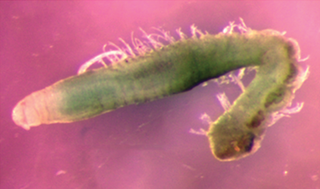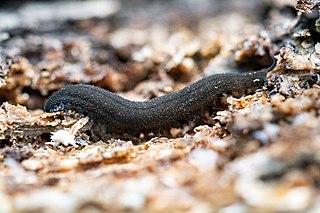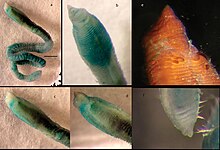
Polychaeta is a paraphyletic class of generally marine annelid worms, commonly called bristle worms or polychaetes. Each body segment has a pair of fleshy protrusions called parapodia that bear many bristles, called chaetae, which are made of chitin. More than 10,000 species are described in this class. Common representatives include the lugworm and the sandworm or clam worm Alitta.

Eunicidae is a family of marine polychaetes. The family comprises marine annelids distributed in diverse benthic habitats across Oceania, Europe, South America, North America, Asia and Africa. The Eunicid anatomy typically consists of a pair of appendages near the mouth (mandibles) and complex sets of muscular structures on the head (maxillae) in an eversible pharynx. One of the most conspicuous of the eunicids is the giant, dark-purple, iridescent "Bobbit worm", a bristle worm found at low tide under boulders on southern Australian shores. Its robust, muscular body can be as long as 2 m. Eunicidae jaws are known from as far back as Ordovician sediments. Cultural tradition surrounds Palola worm reproductive cycles in the South Pacific Islands. Eunicidae are economically valuable as bait in both recreational and commercial fishing. Commercial bait-farming of Eunicidae can have adverse ecological impacts. Bait-farming can deplete worm and associated fauna population numbers, damage local intertidal environments and introduce alien species to local aquatic ecosystems.

The Serpulidae are a family of sessile, tube-building annelid worms in the class Polychaeta. The members of this family differ from other sabellid tube worms in that they have a specialized operculum that blocks the entrance of their tubes when they withdraw into the tubes. In addition, serpulids secrete tubes of calcium carbonate. Serpulids are the most important biomineralizers among annelids. About 300 species in the family Serpulidae are known, all but one of which live in saline waters. The earliest serpulids are known from the Permian.

Cirratulidae is a family of marine polychaete worms. Members of the family are found worldwide, mostly living in mud or rock crevices. Most are deposit feeders, but some graze on algae or are suspension feeders.
Pettais a genus in the polychaetefamily Pectinariidae.
Erinaceusyllis, previously known as Sphaerosyllis, is a genus belonging to the phylum Annelida, a group known as the segmented worms. This genus consists of several species that were previously described as Sphaerosyllis and as Sphaerosyllis erinaceus sub-species, differing by the compound chaetae.
Erinaceusyllis ettiennei is a species belonging to the phylum Annelida, a group known as the segmented worms. E. ettiennei is characterized by its compound chaetae with slender and thin blades, which are curved as a sabre. The most similar species is Erinaceusyllis serratosetosa, but is differentiated by the size of its body and the compound chaetae, which have long and curved marginal spines on its long blades in E. serratosetosa. The species is named in honour of Ettienne Fourie.
Erinaceusyllis cirripapillata is a species belonging to the phylum Annelida, a group known as the segmented worms. E. cirripapillata is characterized by its papillae on its dorsal cirri, one of them being distinctively mushroom-shaped. No species of this genus or Sphaerosyllisis is known to possess this particular kind of papillae. The name of the species refers to these same papillae.

Olev Vinn is Estonian paleobiologist and paleontologist.
Metaperipatus is a genus of velvet worms in the family Peripatopsidae that includes the species Metaperipatus inae. Males of this species have 20 pairs of legs; females have 22 pairs. This species is a dark grayish blue in color, with large orange/red spots. When walking, females of this species can be as long as 85 mm, and males can be as long as 60 mm. The type locality is in central Chile.

Aphelochaeta antelonga is a species of bitentaculate cirratulidan first found in the Pacific coast of Costa Rica, at a shallow subtidal depth of about 11 to 18 metres in the Gulf of Nicoya. It is characterised by possessing a long biannulate peristomium and fibrillated capillary setae.

Aphelochaeta praeacuta is a species of bitentaculate cirratulidan first found in the Pacific coast of Costa Rica, at a shallow subtidal depth of about 11 to 28 metres in Bahia Culebra. It is characterised by possessing a first peristomial annulation that extends as a dorsal crest over the second annulation and first setiger.

Aphelochaeta striata is a species of bitentaculate cirratulidan first found in the Pacific coast of Costa Rica, at a shallow subtidal depth of about 11 to 28 metres in the Gulf of Nicoya. It is characterised by possessing a narrow body and transverse blue stripes across the venter of its setigers 5 through 8.

Chrysopetalidae is a family of polychaete worms. The body is short or elongated, with few or numerous segments. All segments bear on their dorsal side a fan or a transverse row of paleae. The cephalic lobe has tentacles and eyes and the buccal segment has two or four tentacular cirri on each side. The parapodia are uniramous or biramous, with dorsal cirri upon all segments. The ventral bristles are compound.

Peripatopsis overbergiensis, the Overberg velvet worm, is a species of velvet worm in the Peripatopsidae family. This species usually has 19 pairs of legs: 18 pregenital leg pairs plus one last pair that is strongly reduced and without claws or spinous pads. Some individuals, however, have only 18 leg pairs. This species is limited to the Overberg region of South Africa.

Flabelligeridae is a family of polychaete worms, known as bristle-cage worms, notable for their cephalic cage: long slender chaetae forming a fan-like arrangement surrounding the eversible head. Unlike many polychaetes, they also have large, pigmented, complex eyes.
Polyeunoa laevis is a scale worm which is widely distributed in the Southern Ocean and occurs over a wide depth range, from 35m to 2450m.

Flabelligera is a genus of polychaetes in the family Flabelligeridae. Species are common around the world, in both temperate and cold waters. Flabelligera species have long, club-like papillae, which are encased in a smooth mucus sheath. They also have a distinct cephalic cage, and hooked neurochaeatae which they use to hold onto rocks.












